In This Article
Subscribe to our newsletter
Why Automating Video Creation Is No Longer Optional
The demand for video content is exploding. Consumers prefer video-first experiences, and businesses are struggling to meet this growing demand. Maintaining a consistent publishing schedule with traditional video production is increasingly difficult, even with larger budgets. This often creates production bottlenecks, hindering a company’s ability to connect with its audience. Businesses need to find new, more efficient ways to produce high-quality video content.
The Rise of Video and the Bottleneck of Traditional Production
Consumer behavior has fundamentally shifted. Video is no longer a supplementary marketing tactic; it's now the primary way many consume information. This increased demand puts significant pressure on content teams. Traditional video production, with its multiple stages and personnel, can’t keep up. Consider the substantial time investment in scripting, filming, editing, and post-production – all before the video even reaches the audience.
Automation as a Necessary Solution
Automating video creation is no longer just beneficial; it's essential. Automation streamlines video production, enabling businesses to create more content in less time. This efficiency empowers companies to respond to market trends and engage their audience with relevant, timely videos. Furthermore, automation can significantly reduce production costs, making video marketing more accessible to a broader range of businesses.
This rapid growth is driven by the increasing demand for scalable video content across various sectors. The global AI video generator market is expected to grow from $534.4 million in 2024 to $2.56 billion by 2032, representing a 19.5% CAGR. This expansion is fueled by the need for scalable video content across marketing, education, and entertainment. Tools like Synthesia and Lumen5 enable businesses to create personalized videos without actors or cameras, reducing production costs by up to 70% in some instances. North America is leading the innovation charge with a 20.3% CAGR, driven by companies like Adobe and OpenAI. Meanwhile, the Asia-Pacific region held 31.4% of the market share in 2024 due to rapid AI adoption in countries like India and China. Startups like Gan.ai secured $5.25 million in funding in 2024 to further develop personalized video platforms, demonstrating investor confidence in automated video solutions. For a deeper dive into these statistics, check out this resource: Learn more about AI video generator statistics.
Extending Automation Beyond Video Creation
To better understand the impact of automation, explore the practical applications of automated social posting: Automated Social Posting. Automating distribution, particularly social media posting, amplifies the benefits of automated video creation, ensuring your content reaches the widest possible audience. Integrating video creation and distribution into an automated workflow maximizes efficiency and impact. This frees content teams to focus on strategic initiatives like audience engagement and content strategy, rather than time-consuming manual tasks.
Game-Changing Tools That Automate Video Creation
The sheer volume of video content needed today makes automation essential. But which tools truly deliver? Let's explore the key categories of video automation tools transforming content creation: text-to-video generators, template-based platforms, and advanced voice technology.
Text-To-Video Generators: Creating Footage From Scratch
Imagine creating videos solely from text. Text-to-video generators like Synthesia and Pictory AI transform written content into engaging videos. This technology is particularly useful for explainer videos, product demos, and social media content.
These tools often include AI avatars, diverse voiceovers, and libraries of stock footage and music. This enables quick video creation without cameras or actors.
Template-Based Platforms: Scaling Your Brand Assets
For businesses with established brand guidelines, template-based platforms offer a powerful way to automate video creation. Platforms like Canva and Adobe Express provide customizable templates.
You can quickly swap in your logo, colors, fonts, and product images. This ensures consistent branding and reduces production time. These systems excel at creating marketing videos, social media posts, and short animated explainers, all within your brand’s visual identity.
Voice Technology: Achieving Human-Like Narration
Voice technology is crucial for video automation. Advanced AI voice generators offer natural-sounding voices, often eliminating the need for professional voice actors.
These tools can replicate specific accents and intonations, making automated narrations nearly indistinguishable from human speech. This cuts production costs and timelines, especially for content requiring multiple languages or voice styles. For more on AI in video editing, see our guide on Revolutionizing Video Editing.
Choosing the Right Tools: Matching Needs and ROI
Selecting the right tools depends on your needs, technical expertise, and budget. The following data chart highlights key factors to consider when choosing a video automation platform.
The data chart below visualizes the comparison of key features across different video automation platforms.
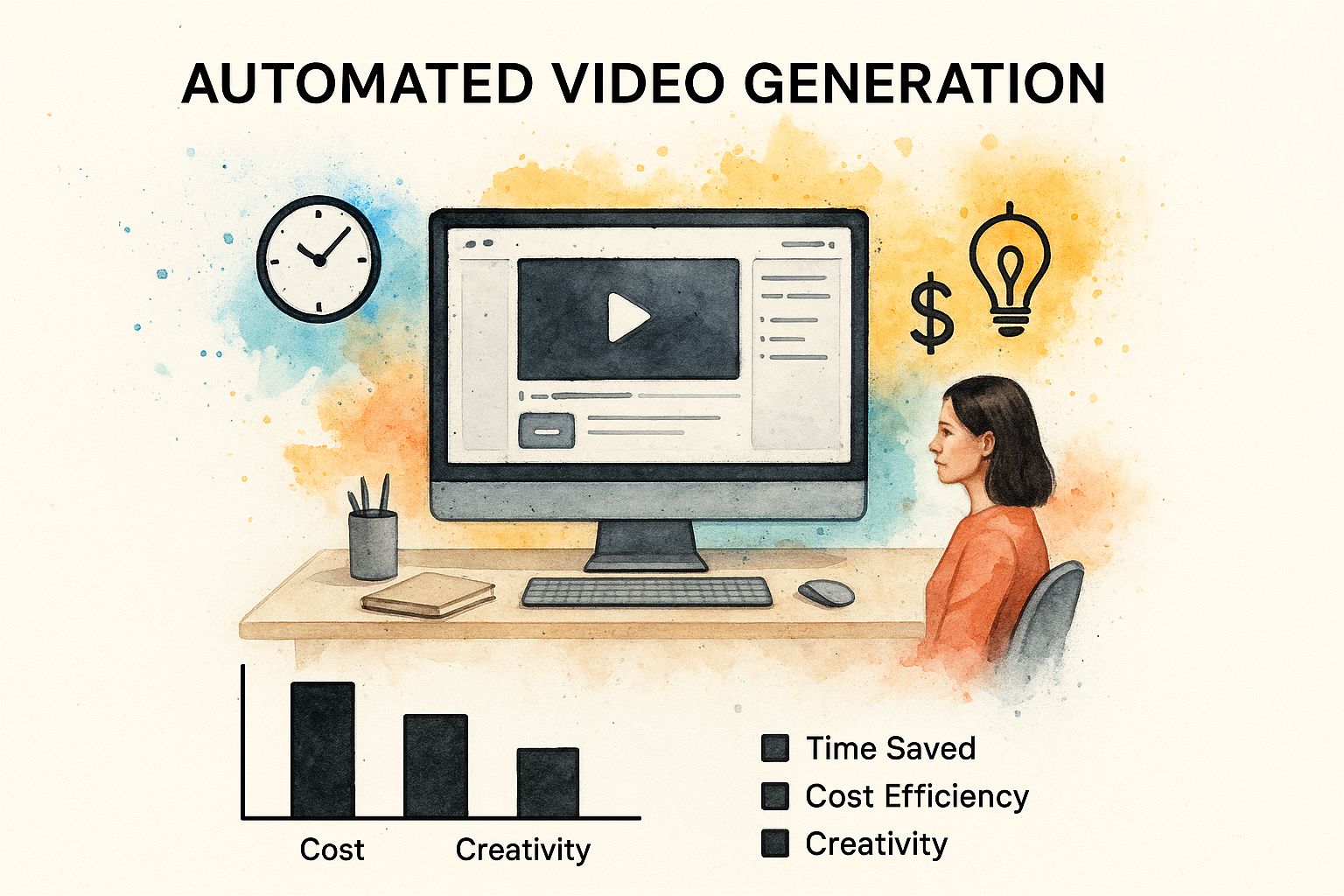
As the chart reveals, template-based platforms offer the best ease of use and branding control.
To provide a more detailed comparison, let's look at the following table:
Comparison of Video Automation PlatformsThis table provides a detailed comparison of the top video automation tools based on key features, pricing models, use cases, and technical requirements.
| Platform | Primary Function | Key Features | Price Range | Best For | Learning Curve |
|---|---|---|---|---|---|
| Synthesia | Text-to-video generation | AI avatars, diverse voiceovers, stock footage | Varies | Explainer videos, product demos | Easy |
| Pictory AI | Text-to-video generation | Automated video editing, script-to-video | Varies | Social media content, short videos | Easy |
| Canva | Template-based video creation | Customizable templates, design tools | Free & Paid | Marketing videos, social media posts | Easy |
| Adobe Express | Template-based video creation | Professional templates, animation tools | Free & Paid | Branded content, animated explainers | Medium |
| Various AI Voice Generators | Voiceover creation | Natural-sounding voices, accent replication | Varies | Narration, voiceovers | Medium |
Template-based platforms excel in ease of use and branding control, making them ideal for teams prioritizing speed and consistent visuals. Text-to-video generators offer balanced customization and scalability, suitable for diverse content needs. Voice technology, while potentially requiring more technical integration, offers excellent scalability and low cost, making it valuable for high-volume video production. Choosing tools aligned with your content strategy and resources remains essential.
The Real Economics of Automating Video Production
Automating video creation offers substantial economic benefits compared to traditional methods. It's not just about cost reduction; it's about optimizing resources and boosting your ROI. Let's explore the financial implications of this shift, examining both the obvious and less apparent costs that impact your bottom line.
Direct Cost Comparisons: Automation vs. Traditional Production
Traditional video production comes with numerous expenses: crew salaries, equipment rentals, studio fees, and post-production editing. These costs can quickly escalate, particularly for high-quality video production. Automation drastically reduces these outlays. AI-powered tools, for example, minimize the need for extensive production crews and costly equipment. This transition significantly lowers the cost per video, an advantage that grows as your production volume increases.
Hidden Costs and Time Savings
Beyond direct costs, traditional production harbors hidden expenses. These often include project management overhead, revisions, and production delays. Automating your workflow minimizes these hidden costs. Automated video creation platforms, for instance, can generate videos in minutes, a stark contrast to the days or weeks often required with traditional methods. This time saved translates directly into cost savings and a faster time to market.
Calculating Your ROI With Video Automation
Determining your potential ROI involves evaluating your current video production costs and comparing them against the projected costs using automation. Consider factors like the number of videos you produce monthly and the time invested in each production stage. This analysis will illuminate the potential financial gains of automation for your specific business needs.
The Growing Landscape of Video Automation
The broader marketing automation landscape, including video tools, is experiencing significant growth. The global marketing automation sector is expected to grow from $5.65 billion in 2024 to $14.55 billion by 2031. Video automation directly benefits from this upward trend. Over 50% of companies increased their video budgets in 2025, according to Wistia's data.
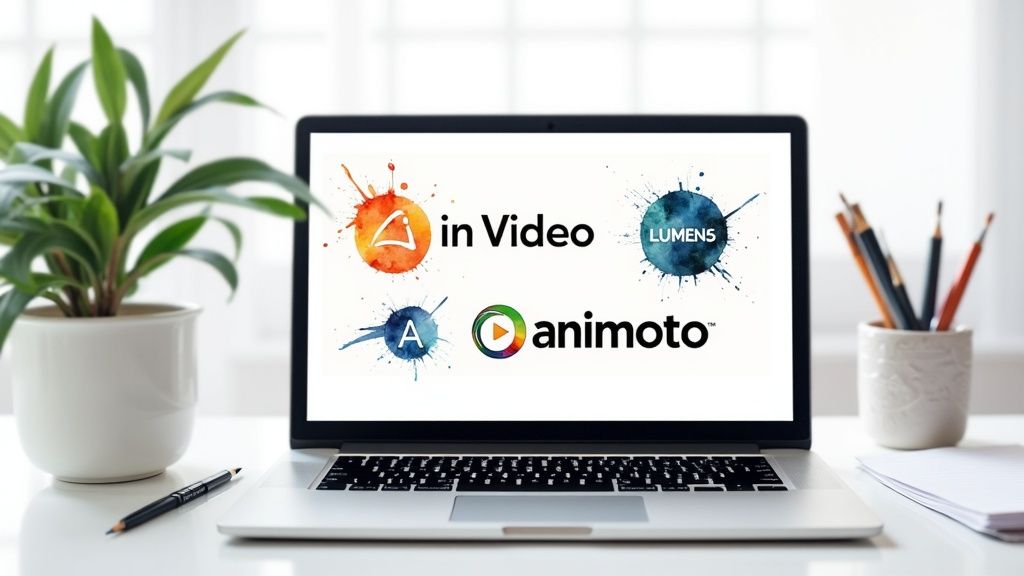
AI-powered platforms are increasingly handling tasks such as transcription, metadata tagging, and audience analysis, mirroring the projected $51.08 billion value of the AI in media market by 2030. AI-generated product demos and social media clips, for example, are becoming commonplace in B2B marketing, with automated workflows reducing editing time from hours to mere minutes. This efficiency also contributes to the growth of 8K/4K video equipment sales in conjunction with automation software, projecting a $296.66 billion hardware market by 2029. Learn more about automation statistics.
Quality Considerations and Premium Production
While automation offers substantial cost advantages, it's crucial to recognize potential quality considerations. For high-end productions requiring intricate visual effects or complex narratives, traditional methods might remain the best approach. However, for many video content types, including explainer videos, social media clips, and product demos, automated video creation tools deliver high quality while significantly reducing cost and time. A balanced approach, leveraging automation for routine content and reserving premium production for select projects, can be the most effective and economical strategy.
Building Video Workflows That Actually Work
Moving beyond theory, how do you create automated video systems that deliver consistent results? The key lies in establishing robust and efficient video workflows. This involves a careful blend of planning, utilizing AI tools, and maintaining quality control throughout the entire process. Let's explore the critical components successful content teams use to build automated video production pipelines that truly work.
Content Planning: The Foundation of Automated Video Creation
Effective automation starts with a well-defined content strategy. This means planning video topics, formats, and target audiences in advance. A clear content calendar ensures your automated system has a steady stream of source material. For example, outlining key messages and storylines before scripting allows AI tools to generate more focused and engaging video content. This initial groundwork is crucial for maximizing the efficiency and effectiveness of your automated video creation process.
Scripting for AI: Optimizing Your Source Material
Once your content plan is in place, scripting becomes the next critical step. However, writing for AI tools differs from traditional scriptwriting. Focus on clear, concise language and structured narratives. Avoid overly complex sentences or ambiguous phrasing. This allows AI to accurately interpret your text and transform it into compelling video content. Consider incorporating relevant keywords to enhance the video's SEO performance. This optimized scripting approach ensures your automated videos are both engaging and easily discoverable. Want to delve deeper into automation? Check out this resource: How to master media workflow automation.
Preparing Visual Assets: Consistency Across Multiple Outputs
Visual consistency is key for maintaining brand identity, especially with automated video creation. Prepare your visual assets–logos, brand colors, and fonts–in advance, ensuring they are readily available for your automated system. This upfront preparation streamlines the video creation process and ensures brand consistency across all outputs. A library of pre-approved stock footage and music can further expedite production. This meticulous preparation allows you to scale your video production while upholding your brand’s visual integrity.
Quality Control and Distribution: Maintaining Standards at Scale
While automation handles the bulk of the work, human oversight is still essential for quality control. Implementing checkpoints throughout your workflow ensures your videos meet brand standards and maintain high quality. This might involve reviewing AI-generated scripts for accuracy and tone, or checking the final video output for visual and audio clarity. This human touch guarantees that your automated videos align with your overall content strategy.
Automated video production is reshaping media workflows, driving a projected $51.08 billion AI media market by 2030. Companies are leveraging tools like Verbit for transcription and Brightcove for publishing, streamlining key processes. The video equipment market, adapting to automation trends, is also expected to reach $296.66 billion by 2029, growing steadily at a 4% CAGR. Hybrid workflows, blending AI efficiency with human creativity, are becoming increasingly common. Find more detailed statistics here.
Furthermore, automating distribution workflows, particularly through platforms like YouTube and social media, maximizes each video’s reach. This ensures your content reaches the right audience at the right time, amplifying the impact of your automated video creation efforts. By combining automated processes with strategic quality control and distribution, you can significantly increase content output while upholding quality and brand consistency.
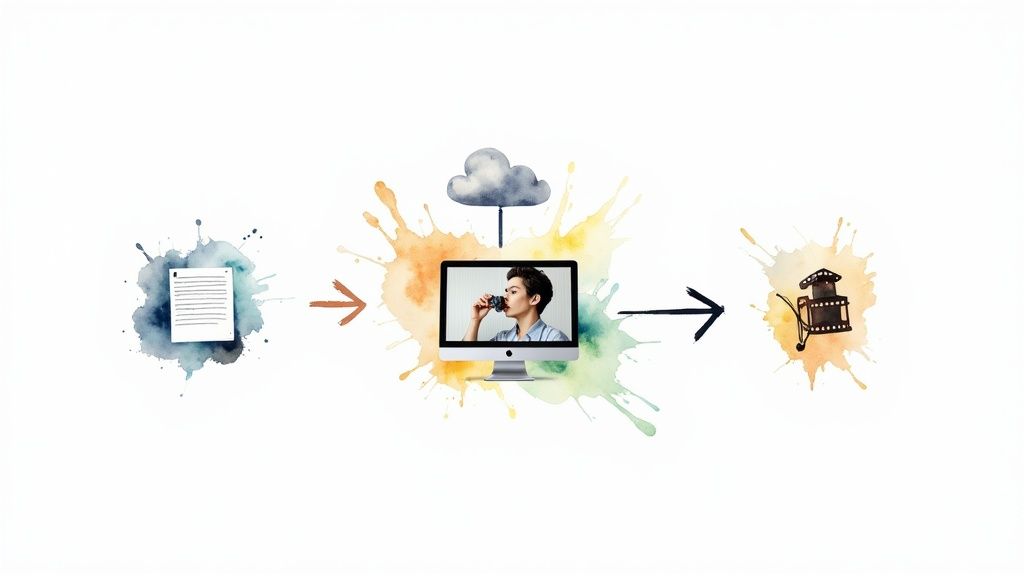
Human Creativity Meets Video Automation
The best video strategies blend automation and human touch. This hybrid approach recognizes that some tasks are perfect for automation, while others truly need human creativity. Let's look at finding that balance.
Where Automation Shines in Video Production
Automation is like having a tireless production assistant. It excels at repetitive tasks, freeing your team for creative work.
Repetitive Elements: Resizing videos, adding lower thirds, or creating intro/outro sequences can be easily automated. This saves valuable time and allows your team to focus on more strategic tasks.
Template-Based Content: For videos like product demos or weekly updates, templates boost efficiency. Automation tools can populate templates with fresh content, ensuring consistent branding and high output.
Localization: Creating multilingual videos can be complex. Automation simplifies this by automating translation and voiceover generation, expanding your global reach.
The Irreplaceable Value of Human Input
Automation streamlines production, but human creativity is still essential for making truly engaging videos.
Creative Direction: Setting the vision, tone, and style of a video requires human insight. Automation tools can execute tasks, but not define the core message or desired emotional impact.
Emotional Storytelling: Connecting with viewers emotionally requires authentic storytelling, a uniquely human skill. Creating compelling narratives and evoking empathy requires nuance and creative flair.
Authentic Brand Voice: Maintaining your brand's unique voice requires human oversight to ensure every video resonates with your target audience and reflects your brand values.
Building a Hybrid Approach: Automation and Human Synergy
The key is to strategically combine automation and human input. Let's examine some key video production tasks and how this hybrid approach can be applied:
To better illustrate this, take a look at the following table:
Table: "Tasks in Video Production: Automation vs. Human Input"
This table outlines various video production tasks and analyzes which are best suited for automation versus those requiring significant human creative input. It also explores potential time savings through a combined approach.
| Production Task | Automation Potential | Human Value Added | Recommended Approach | Time Savings |
|---|---|---|---|---|
| Scripting | Medium | Storytelling, Tone, Brand Voice | AI-generated draft, human editing | 20-30% |
| Visuals | High | Creative Direction, Style | AI-generated options, human selection | 40-50% |
| Editing | High | Pacing, Transitions, Emotional Impact | AI-assisted editing, human refinement | 30-40% |
| Voiceover | Medium | Tone, Emphasis, Emotional Delivery | AI-generated options, human selection/direction | 25-35% |
| Distribution | High | Platform Strategy, Audience Targeting | Automate publishing, human strategy | 60-70% |
As shown in the table, blending automation and human input can significantly improve efficiency. By automating repetitive tasks and focusing human effort on creative elements, you can increase content output and maintain quality. This allows brands to retain their unique visual identity while scaling video content production effectively.
Consider how other areas of your business can benefit from automation, such as business process automation. This isn't about replacing human creativity; it's about empowering it with automation's efficiency.
Success Stories: Transforming Video Production
Moving beyond the theoretical advantages of automating video creation, let's explore real-world examples of how businesses have successfully implemented these strategies. These success stories offer practical insights and demonstrate the tangible benefits of incorporating automation into your video production workflow.
Overcoming Challenges and Achieving Measurable Results
Companies of all sizes and across various industries are embracing video automation to address content creation challenges. For example, a rapidly expanding e-commerce company found it difficult to produce enough product demo videos to keep up with their growing product line. By adopting a text-to-video generator, they were able to create short, engaging product videos directly from product descriptions. This significantly increased their video output and reduced reliance on expensive video shoots, allowing them to launch new products faster and provide customers with more informative video content. For practical tips on improving your video marketing, check out our guide on How to Master Video Ad Creation.
Another example involves a non-profit organization that needed to create multilingual videos for their global outreach campaigns. Traditionally, translating and dubbing videos required significant time and resources. By using automated video translation and voiceover tools, they were able to quickly and cost-effectively create localized video content in multiple languages, significantly expanding their reach and impact.
Real Implementation Timelines and ROI
Implementing video automation isn't always straightforward. Companies often encounter unexpected technical hurdles or internal resistance to new technologies. One marketing team discovered that their existing visual assets weren't optimized for automated video creation. They had to revisit their brand guidelines and develop a library of assets specifically for their automated workflow. While this added an initial setup phase, it ultimately ensured brand consistency across their video output.
Despite these challenges, the ROI of video automation can be significant. The e-commerce company mentioned earlier saw a 30% increase in conversion rates after implementing automated product videos. The non-profit organization significantly expanded its donor base by reaching a wider global audience with localized videos. These results clearly demonstrate the potential of video automation to drive business growth and achieve organizational objectives.
Practical Roadmaps and Key Takeaways
These success stories offer valuable lessons for anyone considering automating their video creation process:
Start Small and Scale: Begin by automating a specific part of your video production, like creating short product demos or social media clips. As you gain experience, gradually expand automation to other areas of your video workflow.
Choose the Right Tools: Carefully evaluate your needs and choose automation tools that align with your content strategy, technical capabilities, and budget.
Address Internal Resistance: Clearly communicate the advantages of video automation to your team and address any concerns about job displacement or creative control. Emphasize how automation can free up time for more strategic and creative work.
By learning from others' experiences and following these best practices, you can successfully manage your own video automation journey and unlock the full potential of video content for your business.
The Future of Automated Video Creation
The field of automated video creation is constantly changing, thanks to advancements in artificial intelligence (AI) and machine learning. These technologies are poised to reshape how we create and share videos, offering exciting new opportunities for businesses and creators.
Generative AI: The Rise of Synthetic Presenters
One of the most significant developments is the emergence of realistic synthetic presenters. Generative AI models can now create lifelike avatars that deliver scripts with natural voices and expressions. This eliminates the need for human actors in many situations, significantly reducing production costs and timelines.
Businesses can now easily create personalized video messages for customers or produce training videos featuring virtual instructors. This allows for scalability and flexibility in video production.
Advanced Personalization: Tailoring Content at Scale
Personalization is becoming increasingly sophisticated in automated video creation. AI algorithms can analyze viewer data and automatically generate videos tailored to individual preferences.
This might involve adjusting the video's message, visuals, or even the language based on viewer demographics, interests, or past behavior. Businesses can deliver highly targeted video content, boosting engagement and conversions. This shift towards hyper-personalization represents a major advance in automated video marketing.
Interactive Video Experiences: Engaging Audiences
Automated video creation is moving beyond personalized messaging towards interactive experiences. Imagine videos that respond to viewer input, offering branching narratives or letting users make choices that influence the outcome.
This interactivity enhances engagement and creates a more immersive experience. It opens new possibilities for personalized learning, interactive product demos, and engaging marketing campaigns.
Positioning for the Future of Video Automation
As these technologies mature, they'll become more integrated into automated video workflows. It's essential for businesses and creators to stay updated on these developments and explore how to incorporate them into their content strategies.
Some technologies, like interactive video, are still developing, while others, like synthetic presenters, are already providing tangible benefits. By understanding which technologies are ready for implementation, you can position yourself for success and gain a competitive edge in the evolving video landscape.
Ready to transform your video creation process? Aeon, an AI-powered video creation platform, empowers publishers to efficiently produce engaging videos. Learn more about Aeon and its powerful features.


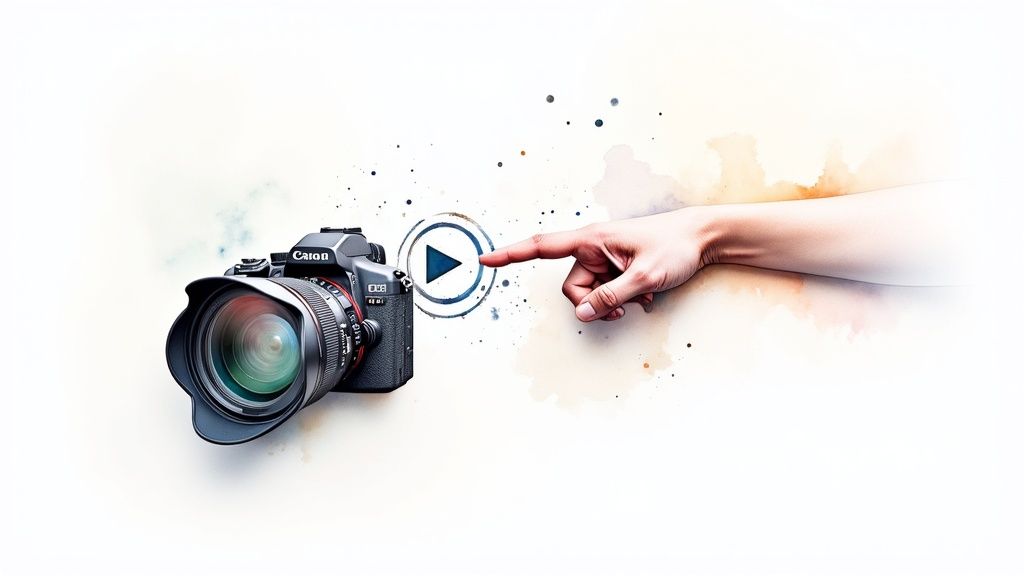
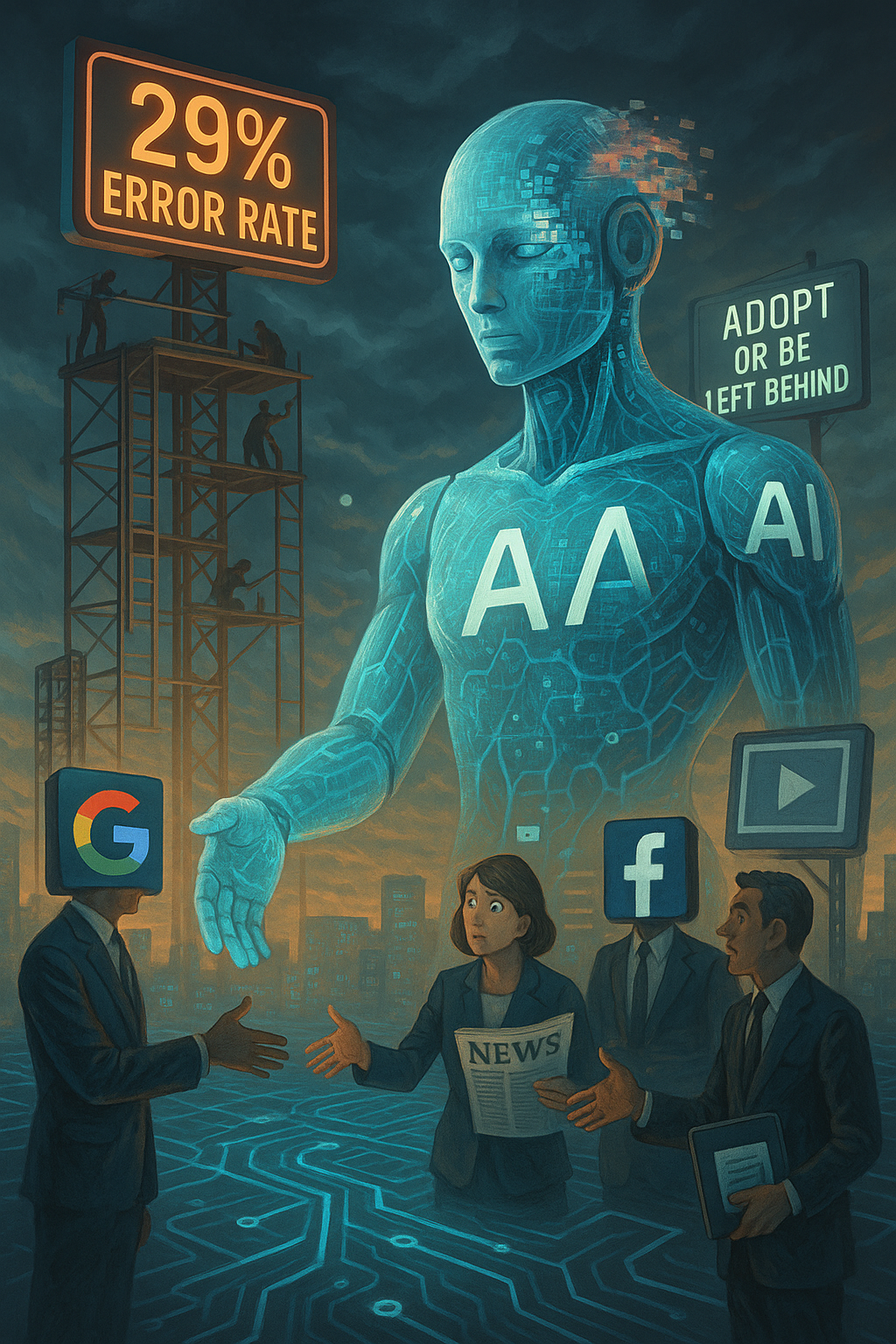


.jpg)